Zeb1-induced metabolic reprogramming of glycolysis is essential for macrophage polarization in breast cancer
- PMID: 35246504
- PMCID: PMC8897397
- DOI: 10.1038/s41419-022-04632-z
Zeb1-induced metabolic reprogramming of glycolysis is essential for macrophage polarization in breast cancer
Abstract
Aerobic glycolysis (the Warburg effect) has been demonstrated to facilitate tumor progression by producing lactate, which has important roles as a proinflammatory and immunosuppressive mediator. However, how aerobic glycolysis is directly regulated is largely unknown. Here, we show that ectopic Zeb1 directly increases the transcriptional expression of HK2, PFKP, and PKM2, which are glycolytic rate-determining enzymes, thus promoting the Warburg effect and breast cancer proliferation, migration, and chemoresistance in vitro and in vivo. In addition, Zeb1 exerts its biological effects to induce glycolytic activity in response to hypoxia via the PI3K/Akt/HIF-1α signaling axis, which contributes to fostering an immunosuppressive tumor microenvironment (TME). Mechanistically, breast cancer cells with ectopic Zeb1 expression produce lactate in the acidic tumor milieu to induce the alternatively activated (M2) macrophage phenotype through stimulation of the PKA/CREB signaling pathway. Clinically, the expression of Zeb1 is positively correlated with dysregulation of aerobic glycolysis, accumulation of M2-like tumor-associated macrophages (TAMs) and a poor prognosis in breast cancer patients. In conclusion, these findings identify a Zeb1-dependent mechanism as a driver of breast cancer progression that acts by stimulating tumor-macrophage interplay, which could be a viable therapeutic target for the treatment of advanced human cancers.
© 2022. The Author(s).
Conflict of interest statement
The authors declare no competing interests.
Figures
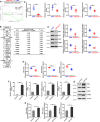


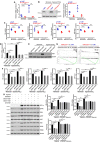
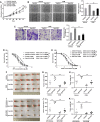
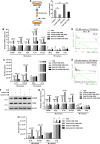
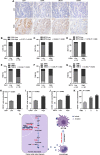
Similar articles
-
ZEB1 enhances Warburg effect to facilitate tumorigenesis and metastasis of HCC by transcriptionally activating PFKM.Theranostics. 2021 Apr 3;11(12):5926-5938. doi: 10.7150/thno.56490. eCollection 2021. Theranostics. 2021. PMID: 33897890 Free PMC article.
-
Hypoxia-induced ZEB1 promotes cervical cancer progression via CCL8-dependent tumour-associated macrophage recruitment.Cell Death Dis. 2019 Jul 1;10(7):508. doi: 10.1038/s41419-019-1748-1. Cell Death Dis. 2019. PMID: 31263103 Free PMC article.
-
Extracellular vesicle-packaged HIF-1α-stabilizing lncRNA from tumour-associated macrophages regulates aerobic glycolysis of breast cancer cells.Nat Cell Biol. 2019 Apr;21(4):498-510. doi: 10.1038/s41556-019-0299-0. Epub 2019 Apr 1. Nat Cell Biol. 2019. PMID: 30936474
-
Tumor microenvironment and metabolic synergy in breast cancers: critical importance of mitochondrial fuels and function.Semin Oncol. 2014 Apr;41(2):195-216. doi: 10.1053/j.seminoncol.2014.03.002. Epub 2014 Mar 5. Semin Oncol. 2014. PMID: 24787293 Review.
-
The Warburg effect: essential part of metabolic reprogramming and central contributor to cancer progression.Int J Radiat Biol. 2019 Jul;95(7):912-919. doi: 10.1080/09553002.2019.1589653. Epub 2019 Mar 22. Int J Radiat Biol. 2019. PMID: 30822194 Review.
Cited by
-
ENO1 Promotes OSCC Migration and Invasion by Orchestrating IL-6 Secretion from Macrophages via a Positive Feedback Loop.Int J Mol Sci. 2023 Jan 1;24(1):737. doi: 10.3390/ijms24010737. Int J Mol Sci. 2023. PMID: 36614179 Free PMC article.
-
cAMP response element-binding protein: A credible cancer drug target.J Pharmacol Exp Ther. 2025 Apr;392(4):103529. doi: 10.1016/j.jpet.2025.103529. Epub 2025 Mar 4. J Pharmacol Exp Ther. 2025. PMID: 40157009 Free PMC article. Review.
-
DOCK8 inhibits the immune function of neutrophils in sepsis by regulating aerobic glycolysis.Immun Inflamm Dis. 2023 Aug;11(8):e965. doi: 10.1002/iid3.965. Immun Inflamm Dis. 2023. PMID: 37647440 Free PMC article.
-
circRNA6448-14/miR-455-3p/OTUB2 axis stimulates glycolysis and stemness of esophageal squamous cell carcinoma.Aging (Albany NY). 2024 May 30;16(11):9485-9497. doi: 10.18632/aging.205879. Epub 2024 May 30. Aging (Albany NY). 2024. PMID: 38819228 Free PMC article.
-
Single-cell Atlas reveals core function of CPVL/MSR1 expressing macrophages in the prognosis of triple-negative breast cancer.Front Immunol. 2024 Dec 24;15:1501009. doi: 10.3389/fimmu.2024.1501009. eCollection 2024. Front Immunol. 2024. PMID: 39776914 Free PMC article.
References
-
- Koppenol WH, Bounds PL, Dang CV. Otto Warburg’s contributions to current concepts of cancer metabolism. Nat Rev Cancer. 2011;11:325–37. - PubMed
Publication types
MeSH terms
Substances
LinkOut - more resources
Full Text Sources
Medical
Molecular Biology Databases
Miscellaneous

